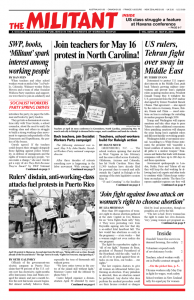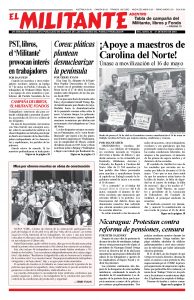LONDON — Marking 10 months since the Grenfell Tower fire, where 72 people were killed and hundreds left homeless, thousands of survivors and supporters marched here April 14. Every month survivors mobilize to demand government action. This was the biggest demonstration to date.
The Grenfell inferno was a disaster waiting to happen, prepared by the callous indifference of government officials and the building’s owners and managers. It was fed by cladding installed on the building’s exterior that was a known fire hazard. There was no sprinkler system in the tower and substandard fire doors that failed to withstand the flames. A poignant moment at each march is when protesters turn in silence to view the still-standing charred remains of the tower, a monument to the rulers’ contempt for working people.
The survivors refuse to let the government’s announcement of a public inquiry into the causes of the fire shift attention away from the need for action now on rehousing and fire safety measures. Their actions have won broad support.
“As we made our way from the Kensington and Chelsea town hall to the tower, local residents leaned out their windows and people on the streets would stop their conversations and face the marchers to show solidarity,” Hugh Robertson, Communist League candidate for Plaistow South in the May 3 local council elections, told the Militant. The League built and joined the protest.
“Solidarity with the fight of the survivors is growing,” he said. “It shows what would be possible if the unions were to get behind the fight for rehousing, for tearing down the flammable cladding on other buildings across the country, and for installation of sprinkler systems in all housing.” Robertson is a member of Unite at the Ford plant in Dagenham.
Dozens of bikers from different clubs, organized by the Muslim motorcycle organization Deen Riders, met at Ace Café in North London to drive through the city and lead off the April 14 march.
“We can’t distance ourselves from such an atrocity,” Jamaal Richards of Deen Riders said at the rally concluding the protest. “We have to ensure everyone gets justice.”
Pavel Viatkin, a young design engineer from Russia who has lived in London for five years, was one of the bikers. “We rode by Parliament to get here. Thousands saw us and were filming us with our signs for Grenfell United. We helped spread the message!” he said.
Speaking for the survivors’ organization Grenfell United, Adel Chaoui announced they hope the next march May 14 will be on Parliament where a debate on the composition of the panel for the public inquiry is scheduled.
“What we call ‘health and safety gone mad’ is wrapping a tower in a petro-chemical blanket,” Chaoui said. The government had deregulated building controls to permit use of flammable cladding. Solidarity actions took place in Liverpool, Bristol, Brighton, Thanet, Southampton and Scotland.
Of the 209 Grenfell households that needed rehousing, only 60 have moved into permanent homes. A further 68 have accepted offers, but are still in emergency housing.
The Labour Party is cynically trying to evade responsibility for the disaster by making use of a leaked report that the spread of the fire was due to shoddy refurbishment work done by the Royal Borough of Kensington and Chelsea.
“The fact that the fire was in Kensington and Chelsea, one of the richest boroughs in the country, highlights the real face of capitalism,” said Catharina Tirsén, Communist League candidate for Longsight in Manchester, who came to London to march. “But it could have happened anywhere. The last Labour government presided over similar accidents waiting to happen around the country. In no borough anywhere — Conservative or Labour — has there been a crash program of sprinkler installation or flammable cladding removal following the fire.”
Over 300 other blocks have been identified as covered with dangerous cladding, according to the government. That includes 158 social housing blocks, 134 private sector buildings and 14 public buildings, including hospitals and schools.

